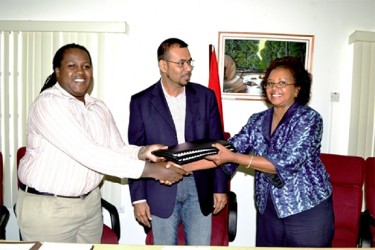Government yesterday clinched a $167M deal with the United Nations Development Programme (UNDP) that will see a range of initiatives to limit damage from mining to the environment, including increased use of satellites
The deal comes amid growing concerns that mining is causing undue deforestation. Guyana recently lost $4B under a forest protection deal with Norway because deforestation – caused mostly by mining – rose above last year’s mark.
Yesterday’s US $803, 653 deal will be used to fund efforts aimed at safeguarding biodiversity areas threatened by mining activities. The Memorandum of Understanding was signed between the Natural Resources Ministry and the UNDP.

A range of project will be undertaken using the financing coming from the Global Environment Fund (GFF). The project is expected to last for three years.
Signing on behalf of the UNDP was Resident Coordinator Khadija Musa, who said the project is important as it will propel a coordinated approach by all stakeholder agencies in the effort to curb the destruction of Guyana’s biodiversity. Permanent Secretary of the Natural Resources Ministry Joslyn McKenzie signed on behalf the ministry. The heads of several agencies under the ministry were also in attendance at the signing.
During the signing ceremony, which took place in the ministry’s boardroom, Executive Director of the Environmental Protection Agency (EPA) Indarjit Ramdass shared that under projects will benefit from parallel funding which is to come from the EPA, the World Wide Fund for Nature (WWF), the Guyana Forestry Commission (GFC) and the ministry.
The funds, he said, will enable a wide array of initiatives, including increased monitoring of mining areas. This will include increasing existing satellite capabilities as well as upping the number of field offices in mining areas. He also said that the first step includes looking at the regulatory systems utilized by all involved agencies, including the GFC, the WWF, the EPA, and the Guyana Geology and Mines Commission (GGMC). Any gaps or loopholes in the system will be closed, he said, while adding that new provisions will be formulated altogether if the need arises.
Ramdass says the project will also be aimed at increasing the consciousness of miners to the biodiversity and the need to protect it as much as possible. This will be accomplished, in part, by developing material to be used in instructions at the recently established Mining School. He said that some of the projects, specifically the creation of monitoring stations and increasing the capacity of the various agencies, have already begun. Others will follow subsequently.
Musa told her colleagues yesterday that countries such as Guyana, being endowed with natural resources, are often tempted to exploit it to foster economic development. While there are pros to development, she cautioned, that the use of such resources without care for the preservation of biodiversity areas can produce a very grim future for some countries, as has been the case.
Meanwhile, Minister of Natural Resources and the Environment Robert Persaud stated government’s “firm commitment” to the proper management and preservation of Guyana’s biodiversity and said the agreement is timely as it coincides with investments already made by government in this regard and will enable agencies to expand the scope of activities being undertaken.
There was no mention of how these funds, if at all, will be used to help combat the despoliation of biodiversity by illegal gold miners. In April, Persaud announced plans to step up the monitoring of mining operations following confirmation that Guyana’s deforestation rate has increased and that the country stood to lose about US$20 million under its performance-based forest protection pact with Norway. The increased deforestation was attributed to illegal mining.




